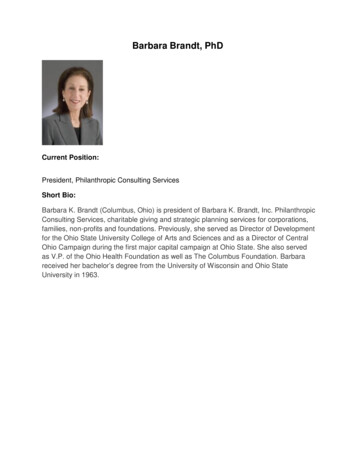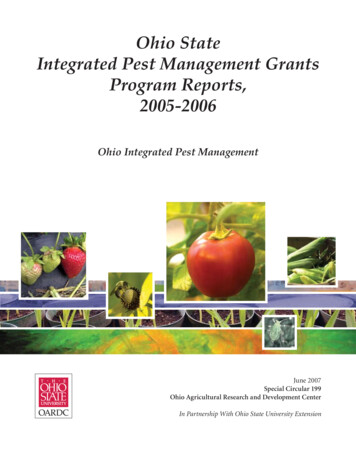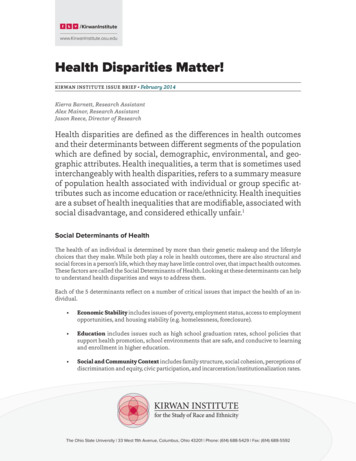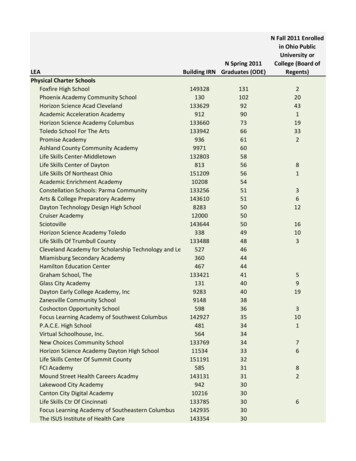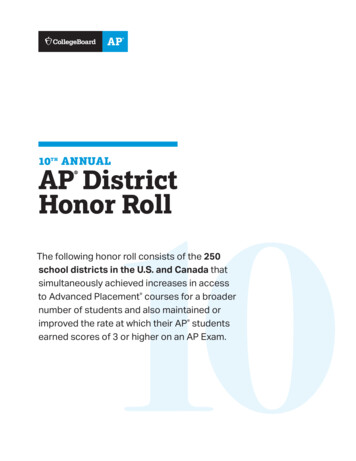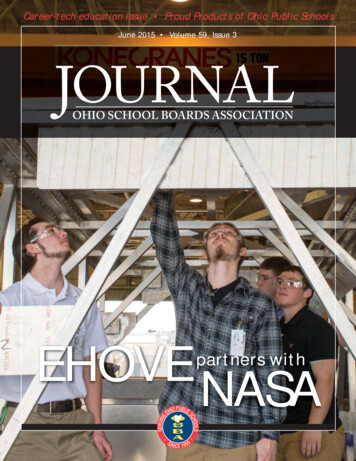
Transcription
Career-tech education issue Proud Products of Ohio Public SchoolsJune 2015 Volume 59, Issue 3JOURNALOHIO SCHOOL BOARDS ASSOCIATIONEHOVEpartners withNASA
Risk Management Solutions withCREATIVITYThe Ohio School Plan is your partner in managing risk. Wehelp you to actively manage risk through comprehensiverisk assessments.Complimentary member services include: School inspection checklist; peer-reviewed by the Ohio SchoolEnvironmental Committee of the Ohio Environmental Health Association Technical assistance and resource materials Inspections by certified playground safety inspectors Interactive bus driver in-service trainingThe Ohio School Plan is exclusively sponsored by BASA, OASBO and OSBA.For more information,call 1-800-288-6821Hylant Administrative Services811 Madison AvenueToledo, Ohio 43604ohioschoolplan.org
Table Of ContentsJOURNALOHIO SCHOOL BOARDS ASSOCIATIONON THE COVERStudents power up NASA project, p. 14Career-tech issue: EHOVE Career Center collaborates with space— photo by Gary Motzagency on mobile solar power plant.FEATURESp. 22Ohio schools, business work to revitalize manufacturingCareer-tech, industry collaborate to fill jobs gap.22A tradition 60 years in the making28Plans under way for the 2015 OSBA Capital Conference and TradeShow.Proud Products of Ohio Public Schools38OSBA recognizes successful past graduates of Ohio public schools.NEWSp. 18DEPARTMENTSp. 4Digital edition available!You can access the Journal’s digitaledition on the OSBA website atwww.ohioschoolboards.org/journal.The evolution of Ohio career-technical education18Career-tech education has long history in Ohio21Thank you, Mr. Perkins, for the legacy you left behind25The unintended impact of report cards on levy success34Schools at center of childhood obesity battle46Executive Outlook3According to Law4Management Insights6Boardmanship8Capital Insider10OSBA: Working for You26OSBA Journal (ISSN 0893-5289) is published bimonthly by the Ohio School Boards Association,8050 N. High St., Suite 100, Columbus, OH 43235-6481. Periodicals postage paid at Columbus, Ohio,and at additional mailing offices. Postmaster: send address changes to OSBA Journal, Attn: Mailroom, OhioSchool Boards Association, 8050 N. High St., Suite 100, Columbus, OH 43235-6481.Comments and articles should be sent to the editor at the above address or emailcdavis@ohioschoolboards.org. The views expressed in articles appearing in OSBA Journal are those of writersand do not necessarily represent OSBA policies or positions.Notice of rights: All rights reserved. No part of this publication may be reproduced or transmitted in anyform by any means, electronic, mechanical, photocopying, recording or otherwise, without the prior writtenpermission of the publisher. For information on permission for reprints and excerpts, contact OSBA.
Who We AreOSBA EXECUTIVE COMMITTEEJOURNAL STAFFCrystal DavisEditorGary MotzManaging EditorEd PenrodEric K. GermannSusie LawsonRandy ReislingJohn W. HalkiasTimothy McKinneyGail RequardtRick FosterPresidentPresident-electImmediate past presidentCentral RegionNortheast RegionNorthwest RegionSoutheast RegionSouthwest RegionAngela PenquiteAssistant Editor/Layout and GraphicsOSBA BOARD OF TRUSTEESAmanda FinneySenior MarketingCoordinator/AdvertisingKevin CrosthwaiteW. Shawna GibbsRandy ReislingLee SchreinerJudy WhiteJeff ChambersDirector of CommunicationServicesRichard Lewis, CAEExecutive DirectorCentral RegionDr. Marguerite Bennett*Northeast RegionDenise BabaThomas F. BropheyAlbert HaberstrohJohn W. Halkias*Robert M. Heard Sr.Susie LawsonVeronica SimsDoug G. StuartNorthwest RegionJaimie L. BeamerMission StatementOSBA leads the way to educationalexcellence by serving Ohio’spublic school board membersand the diverse districts theyrepresent through superior service,unwavering advocacy and creativesolutions. 2015, Ohio SchoolBoards AssociationAll rights reservedOhio School Boards Association8050 N. High St., Suite 100Columbus, OH 43235-6481(614) 540-4000fax (614) 540-4100www.ohioschoolboards.orgEric K. GermannKevin Landin*Timothy McKinneyRobert McPheronLisa SobeckiBob VasquezSoutheast RegionDavid CarterBruce D. NottkeEd PenrodGail Requardt*Kevin E. WeaverSouthwest RegionMark EwingRick FosterGail Martindale*A. Chris NelmsSue SteeleWarren Stevens*Region presidentCONTRIBUTORS TO THIS ISSUEMount Vernon City & KnoxCounty Career CenterNorth Union Local (Union)Columbus CitySouth-Western CitySouth-Western CityLakewood Local (Licking)Streetsboro CityWellsville Local (Columbiana)Trumbull County ESCPlain Local (Stark)Cleveland MunicipalTri-County ESC & WayneCounty Schools Career CenterAkron CityRittman EV & Wayne CountySchools Career CenterSeneca East Local (Seneca) &Vanguard-Sentinel Career andTechnology CentersLincolnview Local (Van Wert)& Vantage Career CenterOttoville Local (Putnam)Bath Local (Allen)Bath Local (Allen)Toledo CityToledo CityEast Guernsey Local (Guernsey)Athens CityLogan-Hocking Local(Hocking) & Tri-CountyCareer CenterEast Muskingum Local(Muskingum) & Mid-EastCareer and Technology CentersCrooksville EV & Mid-EastCareer and Technology CentersBatavia Local (Clermont) &Great Oaks ITCDManchester Local (Adams)Cedar Cliff Local (Greene) &Greene County Career CenterCincinnati CityGoshen Local (Clermont) &Great Oaks ITCDUrbana City & Ohio Hi-PointCareer CenterRichard Lewis, CAECandice L. ChristonMegan GreulichSteve HortonDamon Asbury
Executive OutlookOhio’s CTE — not yourfather’s OldsmobileRichard Lewis, CAE, executive directorOldsmobile once was an icon,the quintessential Americancar built by General Motors.It represented American values andhad a well-respected image, but it didnot evolve. The people who wantedOldsmobiles were older and made upa shrinking market. Young consumerssimply did not want Oldsmobiles.In an effort to change its image, the automanufacturer coined a slogan: “This is notyour father’s Oldsmobile.” The gambitwas an epic failure. Oldsmobile’s existingmarket still wanted its father’s Oldsmobileand bought other models instead. Youngcar buyers looked at the new cars andsaw that they continued to look exactlylike their father’s Oldsmobile.The case, however, could not be moredifferent with Ohio career-technicaleducation. Today’s career-tech centers— once known as vocational schools —clearly belong to the future, not the past.You’ll find many examples of that in thisissue of the Journal.In 2014, the College and CareerReadiness and Success Center atAmerican Institutes for Researchobserved, “Historically, many lowperforming students were tracked intolow-level vocational education coursesthat did not prepare them for access toor success in postsecondary education.”For some, that perception still lingers,as the Ohio Association for Careerand Technical Education points out:“Today, many parents of high schoolage students remember that going tothe vocational school meant you weren’tgoing to college.”That belief cannot be further from thetruth — Ohio career-technical educationnow prepares students for 21st centurycareers and college. The career-technicalassociation notes that, “Career-technicaleducation students must meet the sameacademic requirements of all high schoolstudents as well as complete additionalcourse work in their chosen field. Infact, most students go on to college —almost 60% to 70% according to OhioDepartment of Education stats.”Today’s career-techcenters clearly belongto the future, not thepast.I asked OSBA Immediate Past PresidentSusie Lawson, Tri-County ESC andWayne County Schools Career Center,what the world needs to know aboutcareer-technical education. She sharedwith pride that Ohio’s 49 career centersinstill a strong work ethic while teachinghigh-level technical skills throughhands-on education. They also providethe problem-solving, critical-thinkingand academic skills students need to besuccessful, now and in the future. Thesecenters work collaboratively with students’home school districts, business, industry,community agencies, higher educationand parents to achieve this success.Career centers offer programs such asengineering and science technologies;agricultural and environmentalsystems; manufacturing; law and publicsafety; health sciences; constructiontechnologies; business administration;and many more. A testament to thesuccess of these programs is the fact thatOhio’s career-tech students consistentlyoutperform those from other states innational skill and leadership contests.A cornerstone of the career-tech missionis the commitment to be responsive tolocal employers’ needs for high-quality,skilled workers by helping high school,middle school and adult students connectwith those employers. By providing aneducated, skilled workforce, Ohio careercenters strengthen the economies in thecommunities they serve, since many oftheir students begin careers within a50-mile radius of the centers.Gov. John R. Kasich plainly sees thevalue of career-tech education. In avideo message recognizing Career andTechnical Education Month last year,he said, “In Ohio we have more than120,000 teenagers in our high schoolcareer-tech programs. These schools getit right and their students are findingtheir passion. They are studying a fieldthat motivates them.“They learn math, science and English,but they do something more. Theyapply it to the real world. They takethis opportunity and earn a high schooldiploma, college credit or industrycredentials. I applaud our state’spartners: the students, parents, educatorsand employers in Ohio career-technicaleducation. These folks get it.”Education advocates must continuetrumpeting the success of Ohio’s careercenters to ensure students, parents,policymakers and the public understandtheir vital role in the success of Ohio’sfuture. They must understand these arenot your father’s Oldsmobiles and, asthe governor said, “These folks get it.” nOSBA Journal — June 20153
According to LawSocial media, schoolsand the lawThe social media puzzleCandice L. Christon, staff attorneySchool districts, students, teachersand board members are usingsocial media in different capacities.The Merriam-Webster Dictionarydefines social media as an “electroniccommunication that allows users tocreate online communities to shareinformation, ideas, personal messagesand other content.”Social media is forever changingand adding new websites. I am surethat as you are reading this articlea new social media website is beingcreated. Examples of social mediainclude: Facebook, Instagram, Twitter,LinkedIn, YouTube and blogs, just toname a few. Let’s look at a few of thelegal implications that arise from schooldistricts and individual board membershaving social media pages.Social media and public recordsOhio Revised Code Section (RC)149.43 (A)(1) and 149.011(G)(1)define a public record as a record keptby a public office that containsinformation stored on a fixed medium,regardless of its physical form. Therecord must be created, received, storedor sent under the jurisdiction of a publicoffice. It must document theorganization, functions, policies,decisions, procedures, operations orother activities of the public office. Arecord that satisfies these things will beconsidered a “public record” under thelaw, unless the record is determined tobe exempt.So how does a public record come intoplay when we are dealing with socialmedia? To answer that, let’s take a lookat how social media is being used byschool districts and individual boardmembers. A school district’s socialmedia page is created for the district andrepresents it. It is used to communicatewith the district’s community, staff,students and parents. Alternatively, anindividual board member’s personalsocial media page is generally createdonly for personal use. It is a way forthe board member to communicatewith family and friends. In addition,a personal social media page containspersonal information and represents thatindividual.Your bus solutions provider.SERVICE PARTS BUS SALES LEASING FINANCING INSURANCEWith 10 locations in Ohio, Rush Bus Centers offers exceptional service, parts,leasing, financing and more. We have a wide selection of buses in stock in manyspecifications, including propane and diesel engines. And with our Lease Purchaseprogram, districts have potential to save thousands of dollars per replacement bus.Find a location near you atrushbuscenters.com.BUS CENTERSBoth the district’s social media page andan individual board member’s socialmedia page may be considered a publicrecord if they meet the definition of a“public record.” For example, a schooldistrict’s announcement on itsFacebook page that several schools areclosed due to a gas leak likely meets thedefinition of a public record. This isbecause it contains information that wascreated by the district, and it isdocumenting a decision of the district.There are no exemptions that wouldapply in this case.Let’s consider a board member receivinga question on her personal Facebookpage from a neighbor who has a studentattending the district high school. Theparent’s post asks what the qualificationsand requirements are for students to beaccepted into the Advanced Placementmath program. The board memberresponds to the parent and answers allof her questions about how the programfunctions, how students are selected andhow the program operates. This postalso likely would meet the definition of apublic record because it is documentingthe procedures and operations of thedistrict’s math program.When a district receives a public recordsrequest for something posted on socialmedia, it must analyze the content todetermine if it is a public record. Thedistrict must look beyond the format ofthe post, because what matters is whatis being discussed and whether it meetsthe definition of a public record. If itdoes, the comments must be maintainedin accordance with the district’s recordretention schedule.Other questions to ask are whether4OSBA Journal — June 2015
According to Lawthe comment is the district’s officialcopy or secondary copy. That alsowill help a district determine if thesocial media comment needs to bemaintained. Preserving comments onsocial media pages may be problematic,but many tools and platforms havebeen established to capture the content.For more information on managingsocial media records, please refer to theOhio Electronic Records Committee’sguidelines on “Social Media: TheRecords Management Challenge” tions, comments and posts onsocial media pages can be problematic forschool board members.Comments on a district’s socialmedia pageMost social media websites allowthose viewing and following the pageto post comments. However, somewebsites allow the owner of the pageto turn off the comments section. If adistrict decides to allow comments onits social media page, it has created alimited public forum, which limits thedistrict’s ability to regulate social mediacomments based on the content.Under the First Amendment, the boardmay not restrict access to a public forumonce it has been created, except forreasonable regulations related to thetime, place and manner. The regulationsmust be content-neutral, which meansthe district cannot delete a commentbecause it dislikes an individual or his orher views.Districts should consider addinga disclaimer so the public is awareof the purpose of the page andwhich comments will be deleted.For example, comments that arepromoting illegal activity or usingvulgar language may be removed inaccordance with the disclaimer. Thedistrict should ensure that it informsviewers that the comments, which mayinclude unsolicited advertisementsand hyperlinks, do not represent thethoughts and opinions of the districtor its employees. Comments, removedor not, may still be considered a publicrecord.Open meetings and social mediaAnother area of law that may be affectedby a school district’s social media pageis Ohio’s Open Meetings Law. UnderRC 121.22, school boards are requiredto conduct business and take officialaction in meetings that are open tothe public, unless a topic is permittedto be discussed in executive session.This also applies to board committeesand subcommittees. Under the OpenMeetings Law, a meeting is “anyprearranged discussion by a majorityof the board members about publicbusiness.” If a board member makes acomment about board business on thedistrict’s social media page — or evenon his or her individual page — anda majority of the board’s memberscomment, a court may find a violation ofthe Open Meetings Law.In addition, board members must bepresent in person to be consideredpart of a quorum and to vote. Boardmembers should not use the district’ssocial media page or an individual pageas a way to have board discussions ormake board decisions. Social mediais a great way for boards to makeannouncements or post questions tothe public to receive public opinionon certain matters, but no decisions orcollaborative discussions between andamong board members should be madethere.Individual social media pagesIt is important to remember thatlines may become blurred between adistrict’s social media page and a boardmember’s social media page, because thepublic may not be able to perceive thedifference. When it comes to individualsocial media pages, board membersshould set their privacy settings sotheir page is not public and they knowwho is able to view their information.Without setting the page to private, theinformation on a board member’s pageis not secure.Additionally, board members should beaware of those they are “friending.”Board members should analyze theirimage on their personal pages andthink about what their social mediaprofile is saying about them. How aboard member conducts himself orherself on a personal social media pagemay impact his or her school district,regardless of intent or if the district isexpressly identified.A valuable tool if used properlyHaving a district social media page is agreat way to interact with members ofthe public and keep them informed ondistrict activities and news. However,it is important to remember that withsocial media there is a possibility thatlegal implications may arise.If the district decides to have any type ofsocial media page, it should have a socialmedia policy in place. Always reviewany legal terms and conditions thatare associated with the specific socialmedia website that is being used. Trainyour staff and board members on howto effectively use social media. Have anindividual monitor the district’s socialmedia page so it is aware of what isbeing posted.And finally, always use good judgment,whether on the district’s page or anindividual’s page. n“According to Law” is designed to provideauthoritative general information,sometimes with commentary. It shouldnot be relied upon as legal advice. Iflegal advice is required, the services of anattorney should be obtained.OSBA Journal — June 20155
Management InsightsCareer-tech changes willimpact board policyConnecting students and jobsMegan Greulich, policy consultantCareer-technical education plays abig role in preparing students forthe future. Last year, several billswere passed in Ohio dealing both directlyand indirectly with career-technicaleducation. These legislative changes wereintended to prepare students for theirnext steps after high school.One constant among the legislativechanges is the Ohio Means Jobs website,found at www.ohiomeansjobs.com.The focus of the website and legislativechanges are to help students thinkabout the ways in which what they’relearning now is connected to careersthey might pursue. Let’s look at some ofthe changes and how they impact boardpolicy and district practices.Career-technical education extensionHouse Bill (HB) 487 made severalchanges to career-technical educationand other related topics. The careertechnical changes appear in OhioRevised Code (RC) 3313.90. Althoughmost people have used the term careertechnical education for years, there wasan official terminology change in statutefrom vocational education to careertechnical education. It’s a good idea tocheck board policies to ensure you’re notusing outdated language.Another notable change appears inRC 3313.09(A). This change extendsprovisions for career-technical educationto students enrolled in grades seventhrough 12, where the requirementpreviously only covered students ingrades nine through 12. The goal isto get students involved early andencourage them to think about howtheir current interests can translateinto future careers. According to Ohio6OSBA Journal — June 2015Department of Education (ODE)guidance, determining how to providecareer-technical education to middleschool students is a local decision.The new provisions also allow districtsto opt out of the extension to seventhand eighth-grade students. Boardsmay adopt resolutions specifying theirintent not to provide career-technicaleducation to students enrolled in gradesseven and eight by Sept. 30 each schoolyear. If a waiver request is made, theprovision states that ODE shall waivethe requirement for district participationin the year for which it has been applied.The extension of career-technicaleducation is effective for the 2015-16school year, so districts not alreadyplanning to provide the extendedprogram should prepare the necessarywaiver by the Sept. 30 deadline forthis coming school year. ODE hascreated a guidance document outliningan eight-step process for developing amiddle school career-technical educationprogram. This guidance is available ateducation.ohio.gov by searching “CTEmiddle grade programming.”According to ODE’s guidance, the firststep in creating a middle school programis to contact your career-technicalplanning district lead. Next, districtsshould discuss program ownershipoptions with their lead.In step three, discuss possible programoptions by reviewing the CTE26 (thedesignation for the career-technicaleducation program application) processesand program approval criteria on ODE’swebsite. In step four, districts shoulddiscuss grade-level options.Step five is when districts determinewhether to provide middle schoolcareer-technical programming. Boardschoosing not to provide the programmingshould adopt a local board-approvedresolution and provide it to ODE bySept. 30. Keep in mind, this resolutionmust be adopted annually, and onlyapplies to the year for which it has beenadopted. Alternatively, boards choosing toprovide middle school career-technicaleducation should use this step to developa career pathway and program of studythat reflects the pathway.Districts participating in the extensionfor the 2015-16 school year havealready worked through the remainderof the process. Districts waiving therequirements for the upcoming schoolyear must re-evaluate that choiceannually, and may choose to implementthe extended program in the future.Districts choosing to provide thisprogramming in the future should thenmove on to the next step.In step six, districts develop and submitCTE26, per established time lines,to their assigned career-technicalplanning district lead for review andapproval. In step seven, the applicationis reviewed for approval, disapprovalor determination of no action, perestablished time lines.Finally, in step eight, the careertechnical planning district lead notifiesthe applicant of its decision by March1. If a denial or determination to takeno action occurs, the member districthas the option to appeal the decisionto ODE by March 15. ODE mustapprove or disapprove all applications byMay 15. See ODE’s website for more
Management Insightsinformation on the recommended eightstep process or for other questions.There is no board policy requirement forcareer-technical education, but manydistricts have a statement on the topic.If your board has career-technical policylanguage in place, be sure it is updatedto include the extension to seventh- andeighth-grade students. It’s also a goodtime to review any relevant languageto ensure you’re using the correctterminology, and that no other revisionsare required.Career advisingHB 487 also added RC 3313.6020,which requires board policy on thetopic of career advising. This policymust be in place by the 2015-16 schoolyear, and updated biennially. Careeradvising policies also must be posted ina prominent location on district websitesand made available to students, parents,local postsecondary institutions anddistrict residents. ODE has releasedguidance on this topic, but emphasizesthat implementation of the newrequirements is a local decision.Districts have several responsibilitiesunder the new career advisingrequirements, many of which linkdirectly to career-technical education.ODE recommends using the OhioMeans Jobs website, specifically thebackpack feature, to implement some ofthe new requirements.Part of the new career advising languagerequires districts to develop studentsuccess plans for students identified asat risk of dropping out. ODE providesonline guidance for their development,including sample plans.The plans must address the student’sacademic pathway to successfulgraduation and the role of careertechnical education, competency-basededucation and experiential learningin that pathway. The board also mustconsider how it will identify andpublicize courses in which studentscan earn both traditional academic andcareer-technical credit.The goal of these new requirements is toillustrate how the information studentsare learning in school connects withfuture career opportunities. The careeradvising program also emphasizes therole that career-technical educationmight play in students’ career choices.Contact your policy services providerfor recommended sample language onthe topic. OSBA released sample careeradvising language in the February 2015issue of Policy Development Quarterly,which is available for download tosubscribers. For more information onthe requirements, as well as tools forcustomizing policy language, go toODE’s website: http://education.ohio.gov and search “career advising.”ODE career planning toolHB 393 requires ODE to post andmaintain an online education andcareer planning tool to benefit students.ODE must distribute information onthe planning tool to all public highschools by Sept. 30 each year. In turn,high schools are required to annuallyshare this information with parents andstudents by April 1.The tool will link to ODE’s OhioMeans Jobs website, and is intended toserve as a resource for students to beginthinking about their futures. There areno board policy requirements associatedwith ODE’s career planning tool.Whether focusing on the specific changesto career-technical educationrequirements, or the new provisions thattie back to them, it is clear that careertechnical education plays an importantrole in preparing students for theirfutures. Districts have quite a bit ofleeway in making local decisions on howto implement career-technical programsto provide students the greatest benefits.And don’t forget that ODE has issuedguidance and created tools to helpdistricts along the way. Is your districtdoing enough to promote career-technicaleducation as a tool for student success? Adminisstrative salary analysisNeedNeeedd helelpp deetermmininiining hohoww ttoo comompepenspensatnsateatt yoyourur auraddmindmnisistrrata oro s? It’t s momoreecocompomppliicacatetedted ththanan mostost peosp opplee thihinknk,, annkand OSOSBSBABA hass cono sisidederarablbleble exexpepeeririeencceene iinn thisthiissarrea.eaa. We aree ablle ttoo assssisisst schohoolol disi trricctsts witth a vaarir etetyy of impmpormportatantn ngg:O como pepensnssation clattalasassisi¿csi¿ atationion sysyststememem deessiggnO Mobob ddese criescrripiption creeatatiionion mon mon odidi¿di¿c¿ccatatioatioonO peperfrforormaormaancnce evvalaluau tiuat on ssysyyssteem deesisiggngnFor moFomorer infrenformamatitiiontiono , ccooontnttacct Vana D. KeKeaatinating, didirer ctoctoctorr of manaageememenntt seerrviv cees,s, at(614(61 ) 545 00 40000, (88000 ) 5889-O9-O9OSSBABA, or vkeatkeeaattining@g@ohohioioscsscchhooolo boboara ds.oorgg.OSBA Journal — June 20157
BoardmanshipFive ways to derail thesuperintendent searchChoose your pathSteve Horton, school board services consultantWith the tenure of asuperintendent in Ohioaveraging fewer than fiveyears, it’s likely that every school boardmember in the state will face thedaunting task of replacing a districtsuperintendent. In doing so, the boardenters a critical decision-making processand should “own” the process from startto finish. No one else has responsibilityfor making this decision, and makingthe right one is crucial.OSBA’s professional searchconsultants have seen it all. Mostsearches go from beginning to end withYOU HAVE THE POWER To make your salary budget yield positivereturns to your school system. From jobanalysis to compensation studies to strategicreorganizations, we can help.Visit www.richcompconsulting.com or call(614) 678-8003 to schedule your FREEinitial consultation.8OSBA Journal — June 2015few or any negative issues to address.Others seem to falter a bit and, onoccasion, one will collapse under its ownweight. How can board membersprevent this? Here are five issues that, ifunmitigated, can derail an otherwiseproductive search.Too many cooks in the kitchenRemember, the Ohio Revised Codeclearly states that the board of educationis solely responsible for the hiring andevaluation of the superintendent. Thismeans that the board must decide andvote on that person in public session.But what about the staff members whowill work with and be supervised bythe new superintendent? What aboutcommunity members whose tax dollarspay his or her salary and will feel theimpact of some of the decisions the newhire makes? Shouldn’t they have a say inwho’s hired?These are fair questions. Seeking staffand community input can almostalways add value to the final decision.But beware! There’s a fine line betweenproviding input and attempting to seizecontrol. The board should be strongin
the vocational school meant you weren't going to college." That belief cannot be further from the truth — Ohio career-technical education now prepares students for 21st century careers and college. The career-technical association notes that, "Career-technical education students must meet the same academic requirements of all high school

